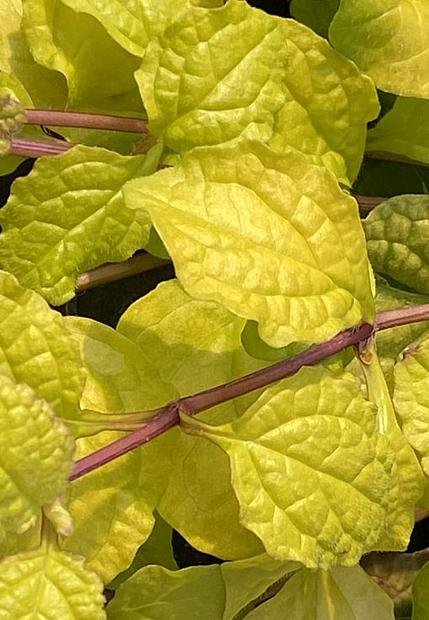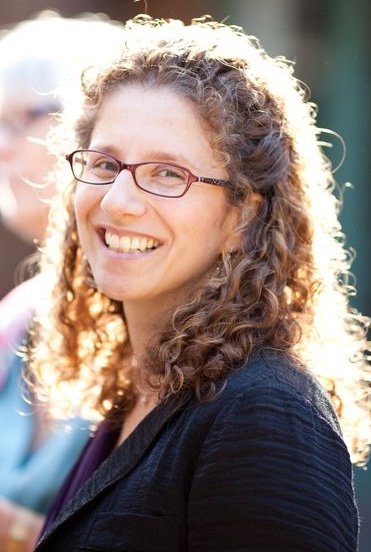Photo courtesy of Susan Choi.
The Next Generation of Designer Plants
APLD Sponsors offer up their favorite new plant this season
Submitted by Amelia Baker, Web Content & iNet Specialist at Devil Mountain Wholesale Nursery
Quercus oblongifolia
Mexican Blue Oak
This one of our special trees in production right now. An evergreen oak common in open woodlands, foothills, and canyons of the Southwest United States. Deep grayish blue leaves are leathery, and populate a broad and open canopy. Bark is deeply fissured and grayish brown. Inconspicuous flowers bloom in May, followed by acorns.
USDA Zones: 6 - 9
Sunset Zones: 1 - 9, 16 - 22
Mature Size: 30 feet high and wide
Light Needs: full sun, partial sun
Water Needs: low
Photo courtesy of Dave Muffly.
Submitted by Janet Sluis, Director of Sunset Western Garden/Perennial Programming & Plant Development Services
Pittosporum tenuifolium ‘Beach Ball’
It’s not brand new, but it hasn’t gotten much attention, and the designers who have used it love it! Once pruned to shape, this extremely compact form is slower growing, and requires fewer maintenance visits than other compact selections. Left unpruned, Beach Ball will form a 3-4' tall by wide ball. Perfect boxwood replacement for containers and low hedges.
Submitted by Laura Hanson, Principal at The Watershed Nursery
Eriogonum nudum ‘Ella Nelson’s Yellow’, Naked Buckwheat
At The Watershed Nursery we focus on seed grown, straight species because we believe in promoting genetic diversity. That being said, we do carry a few native cultivars and a favorite is Ella Nelson’s Yellow Buckwheat. We love the sprays of lemon yellow pom-pom flowers in late spring, and the native bees, honeybees, and butterflies that feed on the nectar. It is also an important host plant for acmon blue butterfly caterpillars.
Submitted by Suzie Wiest, Regional Marketing Representative at Everde Growers
Tecomaria capensis ‘Cape Town’™ series
We’ve been successfully growing and are crazy about the new Tecomaria Cape Town™ series in the Sunset Plant Collection. It has the brightly-colored blooms nearly year-round like the regular species, yet they stay more contained at 4 ft. tall x 3 ft. wide, making them even more versatile.
Submitted by Ryan Meechan of emerisa gardens, inc.
Ajuga reptans Feathered Friends 'Tropical Toucan'
Peren. Herb: Evergreen. Deer, drought & bog toler. Feathered Friends named for its feather-like folg. & the way it mingles nicely w/other plants in combos. First gold colored large-lvd variety! Use in borders, pots, between stones, rock gardens & as a ground cover. Spreads quickly by runners. Attracts butterflies & hummers. Blms: spring-summer. Blm color: cobalt blue. Folg.: vivid gold. Ht.: 4-6". Exp.: pt shade/shade. Water: mod./moist. USDA Z4. PPAF
Designer Tools & Tips
What is the Sunseeker App and how do we use it?
by Gün Ünsal, APLD Bay Area District President
Blue Hibiscus Gardens
Sunnyvale, CA
Although this app is popular with the photographers to estimate where the sun is going to be for events at a later date, it is a boon for horticulturalists and designers as well.
The app is available for Android and for iOS. It has various widgets, but we use the sun trajectory application in the 3D view the most to see how much sun each area of the garden is getting on a given day. Before we start our designs, we note the hours of sun for each relevant location on the summer solstice for the hottest sun. However, you can also note any other dates, especially winter solstice and equinox days easily as these trajectories are shown in different lines in the same view.
This app can also be useful to look at how much your solar panels are going to get exposed or blocked by your neighbor’s house or your tree, etc. See the screen shots taken on an iPhone below.
Follow the red line as you move your phone around to follow the sun’s summer arc. The spring equinox is the green line and the blue show the winter solstice. The yellow line will be the current day trajectory. Look at the hours that you get unfiltered, unobstructed blue skies. Note when you get filtered light through the tree canopy. If you have deciduous trees, but are using the app while the tree has leaves, you will have to imagine in your mind’s eyes where the leaves would start and end if you are interested in guessing the winter exposure. Or if a tree is going to be removed and you know that, you will have to do the imagination in your head and add those sun hours to your notes. It might be beneficial to come back and re-measure if there are going to be a lot of tree canopies that will be removed.
One important note: Make sure to calibrate the app before using it for best accuracy. After calibrating, make sure what you see makes sense as in where the north arrow is or where the sun is currently on the yellow line and the time you are looking at it are a perfect overlap. If not, re-calibrate.
Below are some screen shots using the app to check some specific cases. First example, I am standing in front of a fruit tree and looking at the morning sun situation and the second capture shows the afternoon sun to see why this tree is having such trouble fruiting. In the middle of the day there is a big, dense tree canopy with no direct sunlight. What do you think? Is it a sun exposure issue?
Morning sun for fruit tree in 3D view
Afternoon sun for fruit tree in 3D view
Sun direction at the beginning of June in the Map view for this site
View from second floor window for solar panel investigation
The second example is taken from the second floor window of the house to see if solar panels installed over the first floor roof will get enough sun. This one is specifically checking for the afternoon. Is the nextdoor house going to block the sunlight for the solar panels? This screen capture shows that we have excellent summer sun in the afternoon. The yellow line shows the current day (in this case April 10, 2021). In the spring the sun will set at 5pm over the panels.
Educating the Next Generation
by Debbie Seracini, Membership Chairperson, APLD California Chapter
If you are looking to expand your horticulture knowledge or advance your career, there are quite a few public schools in California that offer A.S. Degrees and/or Certificate programs in Landscape Design and Landscape Architecture. The programs vary at the different schools, and typically focus on developing skills in either designing landscapes or maintaining them. A common thread among them all, however, is the emphasis on sustainability, conservation, and sound horticultural/environmental management and business practices.
It is well known that the future for landscape designers and architects is being shaped by the ongoing threat of global warming, which will put them into more key positions of defending and promoting sustainable practices – especially if they are on a team designing large urban development projects. Designers must consider the dramatic decline in California’s reservoir water levels and the rising recurrence of large wild fires. As urban populations grow and require more green space, combined with the growing demand for carbon sequestration, it is imperative that sustainable practices are incorporated into all landscape designs, no matter how large or small, or whether public or private.
The threat of Covid-19, and the possibility of future pandemics, has also changed the outlook for landscape designers and architects by creating a public demand for more expansive spaces (residential and commercial), that can safely accommodate large functions and more people while social distancing.
California’s colleges and universities are well prepared for teaching the upcoming generation of landscape designers and architects by including sustainable practices ideology in their curriculum. Click the button below for an alphabetical list of the state’s schools with a brief description and/or link to their degree or certificate programs in Landscape Design or Landscape Architecture.
So you want to be a Landscape Designer…
APLD’s DesignShare Mentor Program
by Linda Middleton, FAPLD
Terralinda Design
Walnut Creek, CA
So you want to be a Landscape Designer…
Do you have:
A passion for plants
Artistic talent
Concern for the environment
Problem-solving skills
Formal education or life experience in the landscape industry
A business license
Congratulations! You can be a landscape designer!
But wait, there’s more…
Do you also have:
A knowledge of municipal, state, and federal taxes
Presentation skills
Marketing skills
The ability to identify pests and diseases
Sales acumen
The ability to specify landscape materials
Just a few more…Do you ALSO also have:
Skills to perform a site analysis
Understanding of soils
Insurance coverage
Knowledge of local licensing requirements and ordinances
Satisfactory office skills
Understanding of profit and loss
And, surely you must have:
A legal contract
Understanding of water use and protection
A network of suppliers, vendors, contractors
Reasonable people skills
The skill set is immense, the applications broad, and for many skills, in constant flux. Of course, there are fundamentals skills needed to start a landscape design business. Many skills are learned and perfected over time, experience (successes and failures), and training.
APLD’s DesignShare Mentoring program is a member benefit open to all members. Read about the conversations of recent participants:
“…[my mentor and I] had a conversation regarding how to potentially increase design-build scope within an already established bid-build operation.”
- David Zimmerman, Mentee
“We have decided to focus on her business mission and developing relationships with local landscapers who can support her work.”
- Eileen Kelley, Mentor
“[I] am actually getting tasks done…”
- Adriana Berry, Mentee
“I learned a lot from Victoria about design resources in California and her questions helped me revisit my own design process and think of new ways to approach things.”
- Erin Hutton, Mentor
“I developed a greater passion for desert plants because of Erin’s passion in talking about them and using them in her designs.”
- Victoria Perera, Mentee
For the any member, new skills can be invigorating and paralyzing all at the same time.
A message to all members: promote your strengths and seek assistance with your weaknesses, network with peers, pay it forward.
Every engagement with a colleague is an opportunity to learn, not only for those new to the profession but for seasoned pros.
Read what Erin and Victoria have to say about APLD’s DesignShare:
“APLD’s mentor program gave me the opportunity to share my experience in the landscape design business with a talented up-and-coming designer who I believe will be a steward of the land and serve her clients very well in the future. I’m so grateful to have this opportunity to make a contribution to this program, and to make another new friend in APLD!”
- Erin Hutton, Mentor
“Thank you so much for offering this. It is so important for students and emerging designers like myself who are starting out to be able to connect with and learn from experienced designers. Classroom education will only get you to certain point and there’s no substitute for learning from someone else’s experience in the field. This program has been a critical part establishing a toolkit that I can return to and build on to shape my future practice as a designer.”
- Victoria Perera, Mentee
Mentors are needed for the program, so please do consider sharing your expertise.
Contact: Dawn Losiewicz, Director of Member Engagement












